Liberia |
|
|
|
| Übersicht – Contents: | |
Diese Seite ist Teil des Projektes
Liberia |
|
|
|
| Übersicht – Contents: | |
Flaggen – Flags: |
|
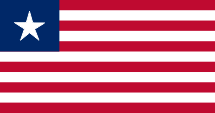 |
National-, Handels- und Marineflagge – national, merchant and naval flag, Seitenverhältnis – ratio = 10:19, Quelle/Source, nach/by: Wikipedia (DE)   |
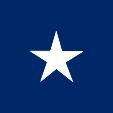 |
Gösch – jack, Seitenverhältnis – ratio = 1:1, Quelle/Source, nach/by: Flags of the World |
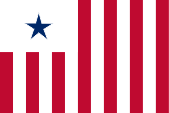 |
Zollflagge – customs flag, Seitenverhältnis – ratio = 2:3, Quelle/Source, nach/by: Flags of the World |
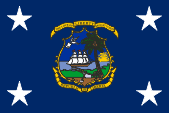 |
Präsidentenflagge – flag of the president, |
historische Flaggen – historical Flags: |
|
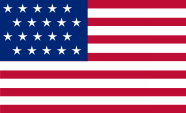 |
1822–1827, |
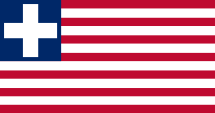 |
1827–1847, |
Bedeutung/Ursprung der Flagge – Meaning/Origin of the Flag: |
|
| Die
heutige Flagge Liberias wurde am 26.07.1847 eingeführt. Sie zeigt elf
Streifen in Rot und Weiß, und im blauen Obereck einen weißen fünfzackigen
Stern. Sie ist zunächst der Flagge der USA nachgebildet, und soll so die politische Abhängigkeit der Republik von den Vereinigten Staaten bzw. das US-amerikanische Erbe der Staatsgründer dokumentieren. Die Farben der Flagge von Liberia werden heute folgendermaßen angegeben: Blau = RGB 0|40|104, was Pantone 281 entsprechen würde, Rot = RGB 191|10|48, was Pantone 193 entsprechen würde. |
The
today's flag of Liberia was introduced on the 26th of July in 1847. It shows
eleven stripes in red and white, and in the blue upper staff corner a white
five-pointed star. It is first of all a copying of the flag of the USA and
should in this way document the political dependence of the republic from
the United States resp. the US-American legacy of the founders of the state.
The colours of the flag of Liberia are now given as follows: Blue = RGB 0|40|104, which would correspond to Pantone 281, Red = RGB 191|10|48, which would correspond to Pantone 193. |
| Ganz am Anfang der Kolonisierung Liberias durch freigelassene schwarze Sklaven aus den USA wurde in Liberia die Flagge der USA verwendet, das Land galt als Kolonie der USA. Im Jahre 1827 wurden die Sterne aus der Flagge entfernt, und durch ein weißes Kreuz ersetzt. Wahrscheinlich wollte man damit den laufenden Modifizierungen der Flagge durch neu aufgenommene USA-Bundesstaaten entgehen. Im Jahre 1845 kam es auf See zu einem Zwischenfall mit einem britischen Schiff, dem die Flagge unbekannt war. Daher wurde beschlossen die Unabhängigkeit zu proklamieren, und eine von den USA besser unterscheidbare Flagge anzunehmen. Die Zahl der Streifen wurde auf elf reduziert, und in die Oberecke kam ein weißer Stern. So erhielt die Flagge ihr heutiges Aussehen. Sie wurde am 26.07.1847 zum Tag der Unabhängigkeit eingeführt. | In the
beginning of the colonization of Liberia by released black slaves from the
USA was in Liberia in use the flag of the USA, the country was considered a colony of the USA. In the year 1827 the stars
were removed from the flag and substituted by a white cross. Probably was
the reason for that doing to avoid the ongoing modifications of this flag by
new incorporated USA federal states. In the year 1845 there was an incident in the ocean with a British ship which did not know the flag. That is why they decide to proclaim the independence and to adope a flag which is better to differentiate from the flag of the USA. The number of the stripes became reduced to eleven and in the upper staff quadrant was positioned a white star. In this way the flag received its today's appearance. It was inroduced on the 26th of July in 1847 on the independence day. |
| Der weiße
Stern auf blauem Grund ist der sogenannte "Freiheitsstern". Er soll darauf
hinweisen, dass Liberia "ein helles Licht im dunklen Kontinent" sei, und
dass zum Zeitpunkt der Gründung der Staat Liberia angeblich der einzige
unabhängige Staat Afrikas gewesen sein soll. Die elf Streifen stehen für die
elf Unterzeichner der Unabhängigkeitserklärung. Es wurde mehrfach versucht, das Aussehen der Flagge "afrikanischen Verhältnissen" anzupassen, bisher immer erfolglos. |
The white
star on the blue ground is the so named "Freedom Star". It should point at
the case that Liberia should be "a lucid light in the dark continent", and
that to the point in time of the foundation of Liberia this state ostensibly
should have been the only independent state of Africa. The eleven stripes stand for the eleven signers of the declaration of independence. There were several attempts to conform the appearance of the flag in "African conditions", hitherto always unsuccessfully. |
| Die Präsidentenflagge ist dunkelblau mit dem Wappen in der Mitte. In jeder Ecke der Flagge befindet sich ein weißer Stern. | The flag of the President is a dark blue with the coat of arms in the middle. In every edge of the flag is one white star. |
| Quelle/Source: Flaggen und Wappen der Welt, Die Welt der Flaggen, Flaggen Wappen Hymnen, Wikipedia (IT) | |
Wappen – Coat of Arms: |
|
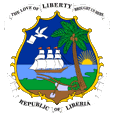 |
Wappen von Liberia – coat of arms of Liberia. Quelle/Source: Corel Draw 4 |
Bedeutung/Ursprung des Wappens – Meaning/Origin of the Coat of Arms: |
|
| Das Wappen wurde am 16.07.1847 eingeführt. Es zeigt ein golden eingefasstes Schild mit einer Küstenlandschaft, einer aufgehenden Sonne, einem Segelschiff, einer weißen Taube mit einer Nachricht und im Vordergrund einen Pflug und eine Schaufel an einer Palme. | The coat of arms was introduced on 16th of July in 1847. It shows a golden bordered shield with a coastal scenery, a rising sun, a sailing ship, a white pigeon with a message and in the foreground a plow and a shovel near a palm tree. |
| Das Schild soll die Entstehungsgeschichte der Republik beschreiben. Die Taube mit der geschriebenen Nachricht symbolisiert die Botschaft des Friedens und guten Willens des Landes an die Völker der Welt. | The shield should describe the history of nascence of the republic. The pigeon with the written message symbolizes the message of peace and of good will of the country to the nations of the world. |
| In dem weißen Schriftband oberhalb des Schildes der Wahlspruch des Landes in schwarzen Lettern: "The Love of Liberty brought us here" → "Die Liebe zur Freiheit brachte uns her". In dem weißen Schriftband unterhalb des Schildes, ebenfalls in Schwarz, der Name des Landes. | In the
white banner above the shield the motto of the country in black characters:
"The Love of Liberty brought us here". In the white banner below the shield, likewise in black characters, the name of the country. |
| Quelle/Source: Flaggen Wappen Hymnen | |
Landkarten – Maps: |
Lage – Position: |
Landkarte des Landes – Map of the Country: |
Zahlen und Fakten – Numbers and Facts: |
|
|
|
|
|
|
|
|
|
|
|
|
|
|
|
|
|
|
|
|
|
|
Geschichte: |
| 1487 ·
der portugiesische Seefahrer Bartolomëu Diaz entdeckt die heutige Küste
Liberias, diese wird später unter dem Namen Pfefferküste bekannt, eine
europäische Kolonisierung erfolgte jedoch nicht 1816 · Gründung der "American Colonization Society" zum Zwecke der Ansiedlung von in den USA freigelassenen schwarzen Sklaven in Afrika 1822 · erste freie Schwarze siedeln sich an der Pfefferküste an 26.07.1822 · Gründung des Staates Liberia in der Gegend des heutigen Monrovia 1834 · Gründung der Schwarzen-Republik Maryland am Kap Palmas 26.07.1847 · Liberia wird unabhängige Republik, bleibt jedoch noch mindestens für 100 Jahre von den USA und zeitweilig sogar von Großbritannien abhängig 1848–1856 · Liberia beginnt die Stämme der Pfefferküste zu unterwerfen und dehnt sich auch ins Landesinnere aus 1857 · die Schwarzen-Republik Maryland wird Liberia angegliedert 1862 · formelle Anerkennung der Unabhängigkeit Liberias durch die USA 1871 · Liberia muss aus wirtschaftlichen Gründen seine Zolleinnahmen bis 1911 an Großbritannien verpachten 1878 · die True Whig Party, die Partei der americo-liberianischen Führungsschicht kommt an die Macht, und bleibt bis 1980 im Amt 1885 · Liberia legt seine heutigen Grenzen zu seinen Nachbarn fest 1906 · Großbritannien leiht Liberia erneut Geld, stellt jedoch dessen Unabhängigkeit in Frage 1911 · die maroden Staatsfinanzen werden internationalisiert 1914 · Aufstand der afrikanischen Einwohner gegen die americo-liberianische Führungsschicht 1930 · Aufstand der afrikanischen Einwohner gegen die americo-liberianische Führungsschicht 1942 · die USA besetzen im Zweiten Weltkrieg Liberia und errichten einen Militärstützpunkt, Liberia muss sich in der Folgezeit auch noch aktiv am Kriege beteiligen 1945 · Wahlrecht für Männer der afrikanischen Bevölkerung 1980 · Militärputsch der afrikanischen Einwohner unter Oberfeldwebel Samuel Doe, Doe wird neuer Präsident 1986 · neue Verfassung 1989 · die Rebellenbewegung der Americo-Liberianer die National Patriotic Front (NPF) unter Charles Taylor beginnt den Widerstand gegen Doe 1990 · Ermordung von Doe durch americo-liberianische Johnson-Milizen, eine Abspaltung der NPF, anhaltender Bürgerkrieg 1997 · Ultimatum zur Entwaffnung der Bürgerkriegsparteien, Parlaments- und Präsidentschaftswahlen, Charles Taylor wird Präsident 1998 · Putschversuch gegen Taylor 1999 · Kämpfe mit Anti-Taylor-Milizen 2003 · Kämpfe und Aufstände gegen Charles Taylor, er verlässt das Land |
History: |
| 1487 ·
the Portugese seafarer Bartolomëu Diaz discovers the today's coast of
Liberia, that will be later known as Pepper Coast, a European colonization
however follows not 1816 · foundation of the "American Colonization Society" for settlement of in the USA released black slaves in Africa 1822 · first free Blacks settle on the Pepper Coast 26th of July 1822 · establishment of the state of Liberia in the area of the today's Monrovia 1834 · establishment of the Black's Republic of Maryland near Cape Palmas 26th of July 1847 · Liberia becomes an independent republic, but remains for leastways 100 years dependent from the USA and temporary even from United Kingdom 1848–1856 · Liberia begins to submit the tribes of the Pepper Coast and expands also into the hinterland 1857 · the Black's Republic of Maryland becomes incorporated into Liberia 1862 · formal recognition of the independence of Liberia by the USA 1871 · Liberia has to lease its customs incomes because of economical reasons until 1911 to United Kingdom 1878 · the True Whig Party, the party of the Americo-Liberian elite comes to the power and remains until 1980 in function 1885 · Liberia fixes its today's borders to its neighbours 1906 · United Kingdom lends Liberia money again, but questions its independence 1911 · the decayed state's finances become internationalized 1914 · riot of the African inhabitants against the Ameriko-Liberian elite 1930 · riot of the African inhabitants against the Ameriko-Liberian elite 1942 · the USA occupy Liberia in the Second World War and establish a military base, Liberia has to join in the afteryears even actively in the war 1945 · suffrage for men of the African population 1980 · military coup d'état of the African residents under Master Sergeant Samuel Doe, Doe becomes new president 1986 · new constitution 1989 · the rebel movement of the Ameriko-Liberians the National Patriotic Front (NPF) under Charles Taylor begins the resistance against Doe 1990 · assassination of Doe by Ameriko-Liberian Johnson's militias, a wing of the NPF, enduring civil war 1997 · ultimatum for disarmament of the civil war parties, elections for parliament and president, Charles Taylor becomes president 1998 · attempted coup d'état against Taylor 1999 · struggles with Anti-Taylor-Militias 2003 · struggles and riots against Charles Taylor, he leaves the country |
| Quelle/Source: Atlas zur Geschichte, Wikipedia (D), Discovery '97 |
Ursprung des Landesnamens – Origin of the Country's Name: |
|
| Der Name "Liberia" geht auf das lateinische Wort "Libertas" oder auch das englische Wort "Liberty" zurück, was beides "Freiheit" heißt. "Liberia" bedeutet dem zu Folge "Freiheitsland". Es ist eine Anspielung auf den Gründungsmythos dieses Staates, die Ansiedlung freigelassener schwarzer Sklaven auf ihrem heimatlichen Kontinent Afrika. | The name
"Liberia" has its roots in the Latin word "Libertas" or also in the English
word "Liberty". "Liberia" means because of that "Country of Freedom". This
is a hint for the foundation-myth of this state, the settlement of released
black slaves on their native continent Africa. |
| Quelle/Source: Volker Preuß | |